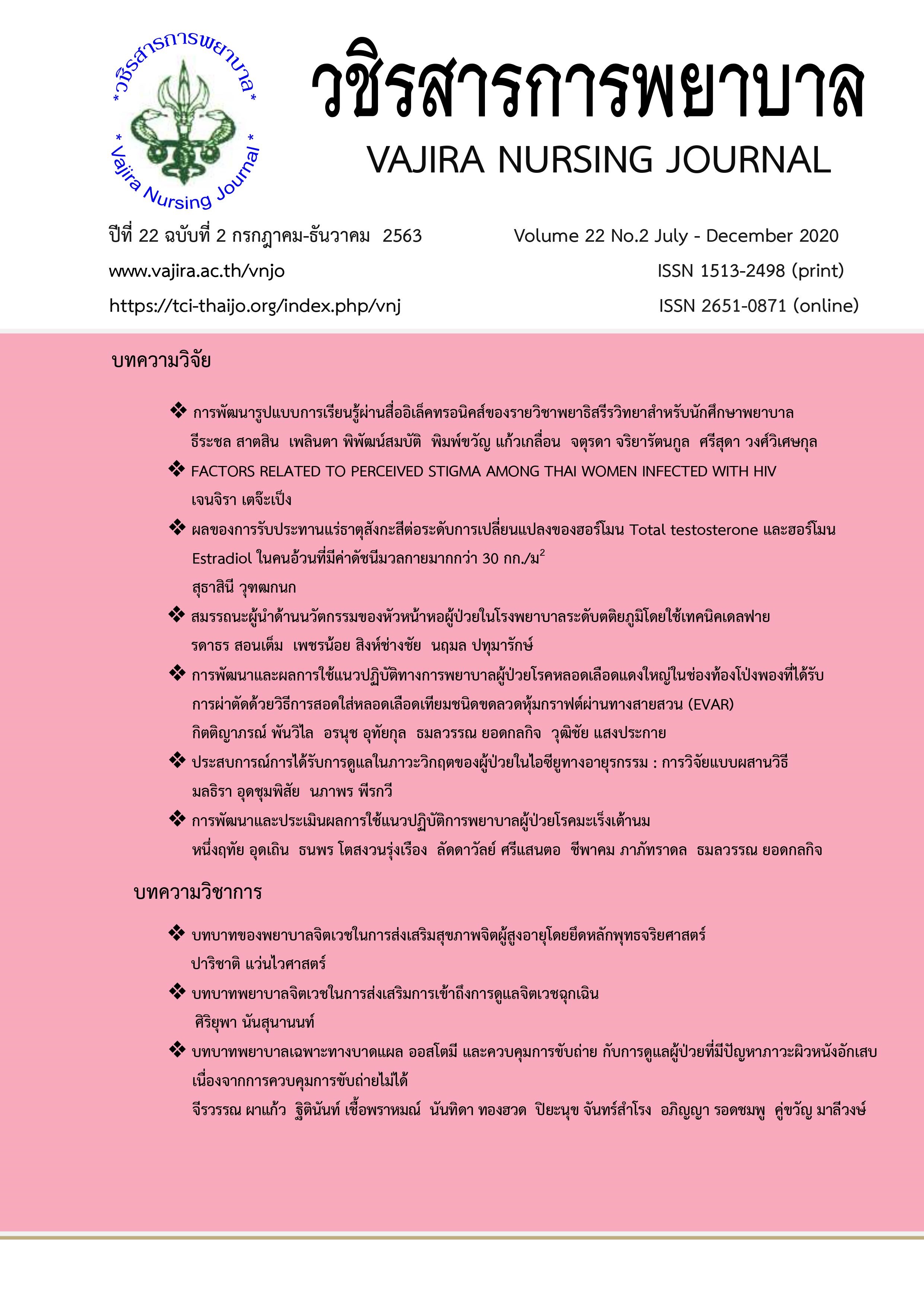Competencies of Innovation Leader of Head Nurses in Tertiary Hospitals Using the Delphi Technique
Main Article Content
Abstract
The objective of this descriptive research was to identify competencies of innovation leader of head nurses in tertiary hospitals using the Delphi method. The sample consisted of 19 experts who were professional nurses with experiences in nursing administration and innovation. Snowball sampling technique was used to recruit the participants. Three rounds of questionnaires provided two sections : open-ended and 5-point rating scale. The data were analyzed by median and interquartile range.
The study found that competencies of innovation leader achieved consensus among experts with median between 4.00-5.00 and the interquartile range was 0.00. These competencies consisted of 10 core competencies and 58 sub-competencies. They were: 1) Learning skills (8 sub-competencies), 2) Creativity and imagination (5 sub-competencies), 3) Energy and motivation (4 sub-competencies), 4) Commitment and sense of belonging (7 sub-competencies), 5) Vision and missions for innovation (5 sub-competencies), 6) Communication, relationship and emotional intelligence (4 sub-competencies), 7) Group and team leading (7 sub-competencies), 8) Understanding of environmental changes (6 sub-competencies), 9) Innovation policy forming (6 sub-competencies), and (10) Management and delegation (6 sub-competencies).
The study indicates that nurse administrators can use these competencies as a guideline for developing an innovation leader program to prepare head nurses in tertiary hospitals. Developing an assessment tool for competencies of innovation leader is also suggested by this result.
Article Details
เนื้อหาและข้อมูลในบทความที่ลงตีพิมพ์ในวชิรสารการพยาบาลถือเป็นข้อคิดเห็นและความรับผิดชอบของผู้เขียนบทความโดยตรง ซึ่งกองบรรณาธิการไม่จำเป็นต้องเห็นด้วย หรือร่วมรับผิดชอบใด ๆ ทั้งสิ้น
บทความ ข้อมูล เนื้อหา รูปภาพ ฯลฯ ที่ได้รับการตีพิมพ์ในวชิรสารการพยาบาล ถือเป็นลิขสิทธิ์ของวชิรสารการพยาบาล หากบุคคลใดหรือหน่วยงานใดต้องการนำทั้งหมดหรือส่วนหนึ่งส่วนใดไปเผยแพร่ต่อหรือเพื่อกระทำการใด ๆ จะต้องได้รับอนุญาตเป็นลายลักอักษรจากวชิรสารการพยาบาลก่อนเท่านั้น
References
เกษณี เทศนา. (2552). อิทธิพลของการอบรมเลี้ยงดู ความฉลาดทางอารมณ์ และลักษณะนิสัยทางการเรียนต่อผลสัมฤทธิทางการเรียนของนักเรียนโรงเรียนสาธิตมหาวิทยาลัยรามคําแหง (รายงานการวิจัย). กรุงเทพฯ: ภาควิชาหลักสูตรและการสอน คณะศึกษาศาสตร์ มหาวิทยาลัยรามคําแหง.
คุณาทิป จำปานิล. (2560). ปัจจัยพหุระดับด้านนวัตกรรมที่ส่งผลต่อสมรรถนะของครูในการจัดการเรียนรู้เพื่อเสริมสร้างทักษะศตวรรษที่ 21. วารสารศึกษาศาสตร์ มหาวิทยาลัยขอนแก่น, 11(3) : 25-35.
จตุพร สังขวรรณ. (2557). ภาวะผู้นําเชิงกลยุทธ์. กรุงเทพมหานคร:ซีเอ็ดยูเคชั่น.
จุฑารัตน์ บันดาลสิน. (2557). การพัฒนาความคิดสร้างสรรค์สู่นวัตกรรมการบริการพยาบาล. วารสารพยาบาลทหารบก, 15(3), 9-17.
ชามาศ ดิษฐเจริญ. (2557). การพัฒนาความคิดสร้างสรรค์และผลสัมฤทธิ์ทางการเรียน ของนักเรียนชั้นมัธยมศึกษาปีที่ 6 โดยการจัดการเรียนรู้แบบโครงงานตามแนวคอนสตรัคชั่นนิซึ่ม ในรายวิชาการเขียนโปรแกรมพัฒนาหุ่นยนต์ประยุกต์. วารสารปัญญาภิวัฒน, 5(2), 205-216.
ดารินทร์ ลิ้มตระกูล. (2557). องค์ประกอบสมรรถนะของพยาบาลหัวหน้าหอผู้ป่วย โรงพยาบาลระดับตติยภูมิในจังหวัดประจวบคีรีขันธ์. วารสารพยาบาล, 63(2), 29-35.
ทินกร บัวชู. (2560). ภาวะผู้นำเชิงนวัตกรรมของหัวหน้าหอผู้ป่วย โรงพยาบาลมหาวิทยาลัยของรัฐ (วิทยานิพนธ์ปริญญามหาบัณฑิต). จุฬาลงกรณ์มหาวิทยาลัย, กรุงเทพมหานคร.
ทินกร บัวชู และสุวิณี วิวัฒน์วานิช .(2560). ภาวะผู้นำเชิงนวัตกรรมของหัวหน้าหอผู้ป่วย โรงพยาบาลมหาวิทยาลัยของรัฐ. วารสารพยาบาลศาตร์ จุฬาลงกรณ์มหาวิทยาลัย, 29(1), 141 – 153.
ผกาวัลย์ อินทรวิชัย. (2558). อิทธิพลของปัจจัยทางการสื่อสารและความเพลิดเพลินในการทำงานต่อความผูกพัน ของพนักงานและพฤติกรรมการเป็นสมาชิกที่ดีขององค์การ. วารสารนิเทศศาสตรปริทัศน์, 21(2) : 380-392.
เพชรน้อย สิงห์ช่างชัย.(2562). ภาวะผู้นำด้านนวัตกรรมสำหรับการบริหารการพยาบาล.วารสารเครือข่ายวิทยาลัยพยาบาลและสาธารณสุขภาคใต้, 6(1), 260-267.
แพรวา พานทอง. (2559). คุณลักษณะผู้นำนวัตกรรมของหัวหน้าหอผู้ป่วยโรงพยาบาลทั่วไป.วารสารพยาบาลศาสตร์ จุฬาลงกรณ์มหาวิทยาลัย, 28(2), 15-24.
รัตติกรณ์ จงวิศาล.(2556). ภาวะผู้นำ: ทฤษฎี การวิจัยและแนวทางสู่การพัฒนา (พิมพ์ครั้งที่ 2). กรุงเทพฯ: สำนักพิมพ์จุฬาลงกรณ์มหาวิทยาลัย.
วาสิตา บุญสาธร.(2556). การสร้างความมุ่งมั่นและพลังขับเคลื่อน เพื่อนำประเทศไทยไปสู่เศรษฐกิจ สร้างสรรค์.วารสารเศรษฐศาสตร์ปริทรรศน์ สถาบันพัฒนศาสตร์, 7(1), 307-355.
สภาการพยาบาล. (2556). สมรรถนะผู้บริหารการพยาบาล. กรุงเทพฯ: จุดทอง.
สำนักการพยาบาล สำนักงานปลัดกระทรวง กระทรวงสาธารณสุข. (2560). แนวทางการพัฒนาคุณภาพบริการ พยาบาลสำหรับโรงพยาบาลชุมชนที่ยกฐานะเป็นโรงพยาบาลทั่วไป. กรุงเทพฯ: สำนักพิมพ์สื่อตะวัน.
สุรางค์ โค้วตระกูล. (2553). จิตวิทยาการศึกษา (พิมพ์ครั้งที่ 9). กรุงเทพฯ: สำนักพิมพ์แห่งจุฬาลงกรณ์มหาวิทยาลัย.
อรอนงค์ โรจน์วัฒนบูลย์. (2554). การพัฒนาตัวแบบผู้นำเชิงนวัตกรรม (วิทยานิพนธ์ปริญญาดุษฎีบัณฑิต). สถาบันบัณฑิตพัฒนบริหารศาสตร์, กรุงเทพมหานคร.
Adair, J. (2009). Effective Leadership: How to Be a Successful Leader. Basingstoke & Hampshire: Pan Books.
American Organization of Nurse Executives.(2005).AONE Nurse Executive Competencies. Chicago, IL: Author.
Bennis, W. (1998). Leadership assessment instrument. Retrieved from http://www.nrcs.usda.gov/
Collier, P. (2001). Differentiated model of role identity acquisition. Symbolic Interaction, 24(2), 217-235.
Gliddon, D.G. (2006). Forecasting A Competency Model For Innovation Leaders Using A Modified Delphi Technique (Doctor dissertation of Philosophy). The Pennsylvania State University, Pennsylvania State.
Gautam, T., Van Dick, R. & Wagner, U. (2004). Organizational identification and organizational commitment: Distinct aspects of two related concepts. Asian Journal of Social Psychology, 7(3), 301-310.
Integro Leadership Institute. (2010). Employee Passion Survey. Retrieved from http://www.integroleadership.com
Jones, M. E., Simonetti, J. L., & Vielhaber-Hermon. M. (2000). Building a stronger organization through leadership development at Parke-Davis Research. Industrial and Commercial Training, 32(2), 44-49.
Macmillan, T. T. (1971). The Delphi Technique. Paper Presented at the annual meeting of the California Junior Colleges Associations Committee on Research and Development, Monterey, California. (May 1971), 3-5.
Michener, H. A., DeLamater, J. D. & Schwartz, S. H. .(1986). Social psychology. San Diego: Harcourt Brace Jovanovich, Publishers.
Mumford, A., & Gold, J. (2004). Management development. London: CIPD.
Niven, P. R. (2003). The importance of terminology to your balanced scorecard. Retrieved from http://www.https://www.researchgate.net/publication
Slowinski, G., Rafii, Z. F., Tao, J. C., & Gollob, L. (2002). After the acquisition: Managing paranoid people in schizophrenic organizations. Research Technology Management, 45(3), 21-33.
World Health Organization. (2016). Nurse educator core competencies. Retrieved from https://apps.who.int/iris/handle/10665/258713


